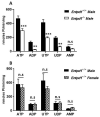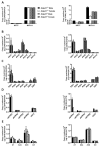NTPDase1 Modulates Smooth Muscle Contraction in Mice Bladder by Regulating Nucleotide Receptor Activation Distinctly in Male and Female
- PMID: 33498759
- PMCID: PMC7911947
- DOI: 10.3390/biom11020147
NTPDase1 Modulates Smooth Muscle Contraction in Mice Bladder by Regulating Nucleotide Receptor Activation Distinctly in Male and Female
Abstract
Nucleotides released by smooth muscle cells (SMCs) and by innervating nerve terminals activate specific P2 receptors and modulate bladder contraction. We hypothesized that cell surface enzymes regulate SMC contraction in mice bladder by controlling the concentration of nucleotides. We showed by immunohistochemistry, enzymatic histochemistry, and biochemical activities that nucleoside triphosphate diphosphohydrolase-1 (NTPDase1) and ecto-5'-nucleotidase were the major ectonucleotidases expressed by SMCs in the bladder. RT-qPCR revealed that, among the nucleotide receptors, there was higher expression of P2X1, P2Y1, and P2Y6 receptors. Ex vivo, nucleotides induced a more potent contraction of bladder strips isolated from NTPDase1 deficient (Entpd1-/-) mice compared to wild type controls. The strongest responses were obtained with uridine 5'-triphosphate (UTP) and uridine 5'-diphosphate (UDP), suggesting the involvement of P2Y6 receptors, which was confirmed with P2ry6-/- bladder strips. Interestingly, this response was reduced in female bladders. Our results also suggest the participation of P2X1, P2Y2 and/or P2Y4, and P2Y12 in these contractions. A reduced response to the thromboxane analogue U46619 was also observed in wild type, Entpd1-/-, and P2ry6-/- female bladders showing another difference due to sex. In summary, NTPDase1 modulates the activation of nucleotide receptors in mouse bladder SMCs, and contractions induced by P2Y6 receptor activation were weaker in female bladders.
Keywords: NTPDase1; P2Y6 receptor; bladder; contraction; extracellular nucleotides; sex; smooth muscle cells.
Conflict of interest statement
The authors declare no financial or commercial conflict of interest.
Figures








Similar articles
-
The ecto-nucleotidase NTPDase1 differentially regulates P2Y1 and P2Y2 receptor-dependent vasorelaxation.Br J Pharmacol. 2010 Feb 1;159(3):576-85. doi: 10.1111/j.1476-5381.2009.00566.x. Epub 2010 Jan 8. Br J Pharmacol. 2010. PMID: 20067476 Free PMC article.
-
NTPDase1 (CD39) controls nucleotide-dependent vasoconstriction in mouse.Cardiovasc Res. 2010 Jan 1;85(1):204-13. doi: 10.1093/cvr/cvp265. Cardiovasc Res. 2010. PMID: 19640930 Free PMC article.
-
Nucleoside triphosphate diphosphohydrolase-1 ectonucleotidase is required for normal vas deferens contraction and male fertility through maintaining P2X1 receptor function.J Biol Chem. 2014 Oct 10;289(41):28629-39. doi: 10.1074/jbc.M114.604082. Epub 2014 Aug 25. J Biol Chem. 2014. PMID: 25160621 Free PMC article.
-
Purinergic transmission in blood vessels.Auton Neurosci. 2015 Sep;191:48-66. doi: 10.1016/j.autneu.2015.04.007. Epub 2015 Apr 25. Auton Neurosci. 2015. PMID: 26004513 Review.
-
Extracellular nucleotides in smooth muscle contraction.Biochem Pharmacol. 2024 Feb;220:116005. doi: 10.1016/j.bcp.2023.116005. Epub 2023 Dec 22. Biochem Pharmacol. 2024. PMID: 38142836 Review.
Cited by
-
Ectonucleotidases and purinergic receptors in mouse prostate gland.Am J Clin Exp Urol. 2025 Apr 25;13(2):145-155. doi: 10.62347/NGQZ2940. eCollection 2025. Am J Clin Exp Urol. 2025. PMID: 40400995 Free PMC article.
-
Spatial mapping of ectonucleotidase gene expression in the murine urinary bladder.Front Physiol. 2023 Nov 30;14:1306500. doi: 10.3389/fphys.2023.1306500. eCollection 2023. Front Physiol. 2023. PMID: 38098806 Free PMC article.
-
Mechanosensitive Hydrolysis of ATP and ADP in Lamina Propria of the Murine Bladder by Membrane-Bound and Soluble Nucleotidases.Front Physiol. 2022 Jun 16;13:918100. doi: 10.3389/fphys.2022.918100. eCollection 2022. Front Physiol. 2022. PMID: 35784885 Free PMC article.
References
-
- Abbracchio M.P., Burnstock G., Boeynaems J.M., Barnard E.A., Boyer J.L., Kennedy C., Knight G.E., Fumagalli M., Gachet C., Jacobson K.A., et al. International Union of Pharmacology LVIII: Update on the P2Y G protein-coupled nucleotide receptors: From molecular mechanisms and pathophysiology to therapy. Pharmacol. Rev. 2006;58:281–341. doi: 10.1124/pr.58.3.3. - DOI - PMC - PubMed
Publication types
MeSH terms
Substances
LinkOut - more resources
Full Text Sources
Other Literature Sources
Research Materials

